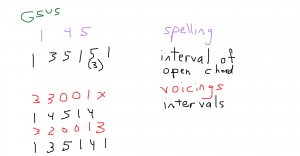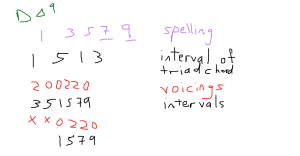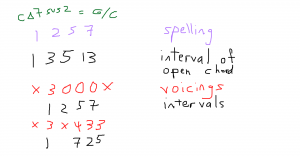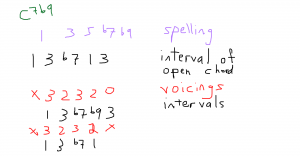Theory
spelling chords
part 4: spelling advanced open chords
instructions:
a) take any basic major or minor triad or 7th chord (examples: F, Bbm7, etc.)
example: Dm
—
b) spell chord in letters using any of these 1. your knowledge of circle of fifths 2. doing wwhwwwh to figure out a particular major scale or whwwhww for minor scale 3. use notes displayed for each key in harmonized scale chart
example: 1. keys of F & Dm both have 1 flat, bb, so Dm scale is d e f g a bb c 2. starting on d and doing whwwhww we get same answer, it just takes a lot longer than method 1 3. find Dm in the list under column I in the “minor” harmonized scale chart and skip every other note from the notes listed across that row, we get d f a
—
c) recall the intervals for your chord in question, then write out the voicing you are playing in terms of intervals
The intervals of each chord type are:
major chords: 1 3 5
major 7 chords: 1 3 5 7
dominant 7 chords: 1 3 5 b7
minor chords: 1 b3 5
minor 7 chords: 1 b3 5 b7
example: a Dm chord is d f a, or 1 b3 5, and the voicing we’ll use is xx0231. The note on the 4th string is a d so that’s a 1, the 3rd string note is a so that’s 5, the 2nd strings is d so that’s 1; the 1st string is f so that’s b3. Thus our voicing in intervals is spelled, from bottom to top (6th to 1st string), 1 5 1 b3
—-
d) from the “chord-interval chart,” choose a different one from the one you started with, and try to figure out the new voicing
example: we will choose “Cm6/9” from the minor chord list in the chord-interval chart, and note that the intervals are 1, b3, 5, 6, 9 so we are looking for a way to add 6 and 9 to our 1 b3 5. If we take the 1 (d – 3rd fret, 2nd string) down to 6 (b – open 2nd string), that’s our 6. For 9, which is the same as 2, we could take the b3 on the 1st string (f) down 1 fret to get 2 (open e string). The resultant voicing will be xx0200 which is spelled, in intervals from bottom to top, 1 5 6 2. Technically this is a D69 (no 3rd) but can be used in the context of Dm as an embellishment chord.
e) repeat steps with additional chords





